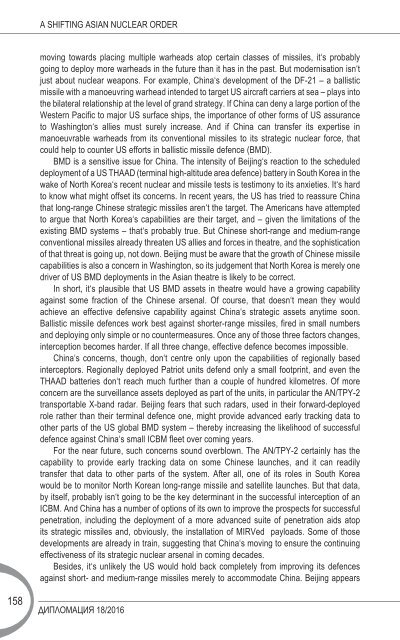DIPLOMACY ДИПЛОМАЦИЯ
2kGfdFv
2kGfdFv
Create successful ePaper yourself
Turn your PDF publications into a flip-book with our unique Google optimized e-Paper software.
A SHIFTING ASIAN NUCLEAR ORDER<br />
moving towards placing multiple warheads atop certain classes of missiles, it’s probably<br />
going to deploy more warheads in the future than it has in the past. But modernisation isn’t<br />
just about nuclear weapons. For example, China’s development of the DF-21 – a ballistic<br />
missile with a manoeuvring warhead intended to target US aircraft carriers at sea – plays into<br />
the bilateral relationship at the level of grand strategy. If China can deny a large portion of the<br />
Western Pacific to major US surface ships, the importance of other forms of US assurance<br />
to Washington’s allies must surely increase. And if China can transfer its expertise in<br />
manoeuvrable warheads from its conventional missiles to its strategic nuclear force, that<br />
could help to counter US efforts in ballistic missile defence (BMD).<br />
BMD is a sensitive issue for China. The intensity of Beijing’s reaction to the scheduled<br />
deployment of a US THAAD (terminal high-altitude area defence) battery in South Korea in the<br />
wake of North Korea’s recent nuclear and missile tests is testimony to its anxieties. It’s hard<br />
to know what might offset its concerns. In recent years, the US has tried to reassure China<br />
that long-range Chinese strategic missiles aren’t the target. The Americans have attempted<br />
to argue that North Korea’s capabilities are their target, and – given the limitations of the<br />
existing BMD systems – that’s probably true. But Chinese short-range and medium-range<br />
conventional missiles already threaten US allies and forces in theatre, and the sophistication<br />
of that threat is going up, not down. Beijing must be aware that the growth of Chinese missile<br />
capabilities is also a concern in Washington, so its judgement that North Korea is merely one<br />
driver of US BMD deployments in the Asian theatre is likely to be correct.<br />
In short, it’s plausible that US BMD assets in theatre would have a growing capability<br />
against some fraction of the Chinese arsenal. Of course, that doesn’t mean they would<br />
achieve an effective defensive capability against China’s strategic assets anytime soon.<br />
Ballistic missile defences work best against shorter-range missiles, fired in small numbers<br />
and deploying only simple or no countermeasures. Once any of those three factors changes,<br />
interception becomes harder. If all three change, effective defence becomes impossible.<br />
China’s concerns, though, don’t centre only upon the capabilities of regionally based<br />
interceptors. Regionally deployed Patriot units defend only a small footprint, and even the<br />
THAAD batteries don’t reach much further than a couple of hundred kilometres. Of more<br />
concern are the surveillance assets deployed as part of the units, in particular the AN/TPY-2<br />
transportable X-band radar. Beijing fears that such radars, used in their forward-deployed<br />
role rather than their terminal defence one, might provide advanced early tracking data to<br />
other parts of the US global BMD system – thereby increasing the likelihood of successful<br />
defence against China’s small ICBM fleet over coming years.<br />
For the near future, such concerns sound overblown. The AN/TPY-2 certainly has the<br />
capability to provide early tracking data on some Chinese launches, and it can readily<br />
transfer that data to other parts of the system. After all, one of its roles in South Korea<br />
would be to monitor North Korean long-range missile and satellite launches. But that data,<br />
by itself, probably isn’t going to be the key determinant in the successful interception of an<br />
ICBM. And China has a number of options of its own to improve the prospects for successful<br />
penetration, including the deployment of a more advanced suite of penetration aids atop<br />
its strategic missiles and, obviously, the installation of MIRVed payloads. Some of those<br />
developments are already in train, suggesting that China’s moving to ensure the continuing<br />
effectiveness of its strategic nuclear arsenal in coming decades.<br />
Besides, it’s unlikely the US would hold back completely from improving its defences<br />
against short- and medium-range missiles merely to accommodate China. Beijing appears<br />
158<br />
<strong>ДИПЛОМАЦИЯ</strong> 18/2016


